Types of Grass Used in Golf Courses Around the World
Golf course turf selection is a critical aspect of course design, maintenance, and playability, with different grass types offering unique advantages depending on climate, soil conditions, and intended use. From the cool, smooth putting surfaces of bentgrass in temperate zones to the drought-resistant, salt-tolerant capabilities of seashore paspalum in coastal environments, each species plays a vital role in shaping the playing experience. The following articles explore the most commonly used grasses on golf courses around the world, examining their characteristics, regional suitability, seasonal behavior, and how they affect both course management and gameplay.
Bentgrass
 Bentgrass, particularly creeping bentgrass (*Agrostis
stolonifera*), is one of the most preferred turfgrasses for
cool-season golf courses, especially in North America and Northern
Europe. It thrives in temperate climates and is most commonly used
on putting greens due to its fine texture and ability to be mowed
to extremely low heights without losing density. Countries such as
the United States, Canada, the UK, Germany, and the Netherlands
commonly use bentgrass on high-end golf facilities, particularly
those hosting PGA Tour events or aiming for fast, true greens. It
prefers cooler temperatures and grows best during spring and fall,
making it less suited for regions with hot, humid summers unless
maintained with precision irrigation and fungicide
management.
Bentgrass, particularly creeping bentgrass (*Agrostis
stolonifera*), is one of the most preferred turfgrasses for
cool-season golf courses, especially in North America and Northern
Europe. It thrives in temperate climates and is most commonly used
on putting greens due to its fine texture and ability to be mowed
to extremely low heights without losing density. Countries such as
the United States, Canada, the UK, Germany, and the Netherlands
commonly use bentgrass on high-end golf facilities, particularly
those hosting PGA Tour events or aiming for fast, true greens. It
prefers cooler temperatures and grows best during spring and fall,
making it less suited for regions with hot, humid summers unless
maintained with precision irrigation and fungicide
management.
One of the key reasons bentgrass is favored on greens is its ability to form a smooth, tightly knit turf surface that supports consistent ball roll and precise shot-making. It establishes well from seed and recovers relatively quickly from wear, allowing golf course superintendents to maintain high-quality playing conditions. However, this grass requires diligent management—especially with water, nutrients, and disease control—since it is prone to issues like dollar spot, brown patch, and heat stress when temperatures rise. These challenges can increase maintenance costs and the need for experienced turf managers.
Bentgrass is also used on tees and fairways in cooler climates, although less frequently than on greens. It tolerates close mowing better than most other grasses, and modern varieties have been bred for increased disease resistance and reduced thatch accumulation. Its ability to spread via stolons makes it excellent for achieving uniform coverage, but it can also become invasive in areas where other turfgrasses are planted, such as collars or roughs. Proper mowing patterns, edging, and cultural controls help manage its spread outside of target zones.
From a golfer's perspective, bentgrass greens are considered ideal for putting due to their speed, trueness, and responsiveness to spin. Its soft blades allow for approach shots to hold the green, and ball marks are typically easy to repair. While it performs best in regions with cool nights and moderate daytime temperatures, technological advances in irrigation systems, fans, and turf breeding have extended its viable range farther south than before. Nonetheless, bentgrass remains most practical for courses in climates where summer temperatures remain under 85°F (29°C) for extended periods.
Bermudagrass
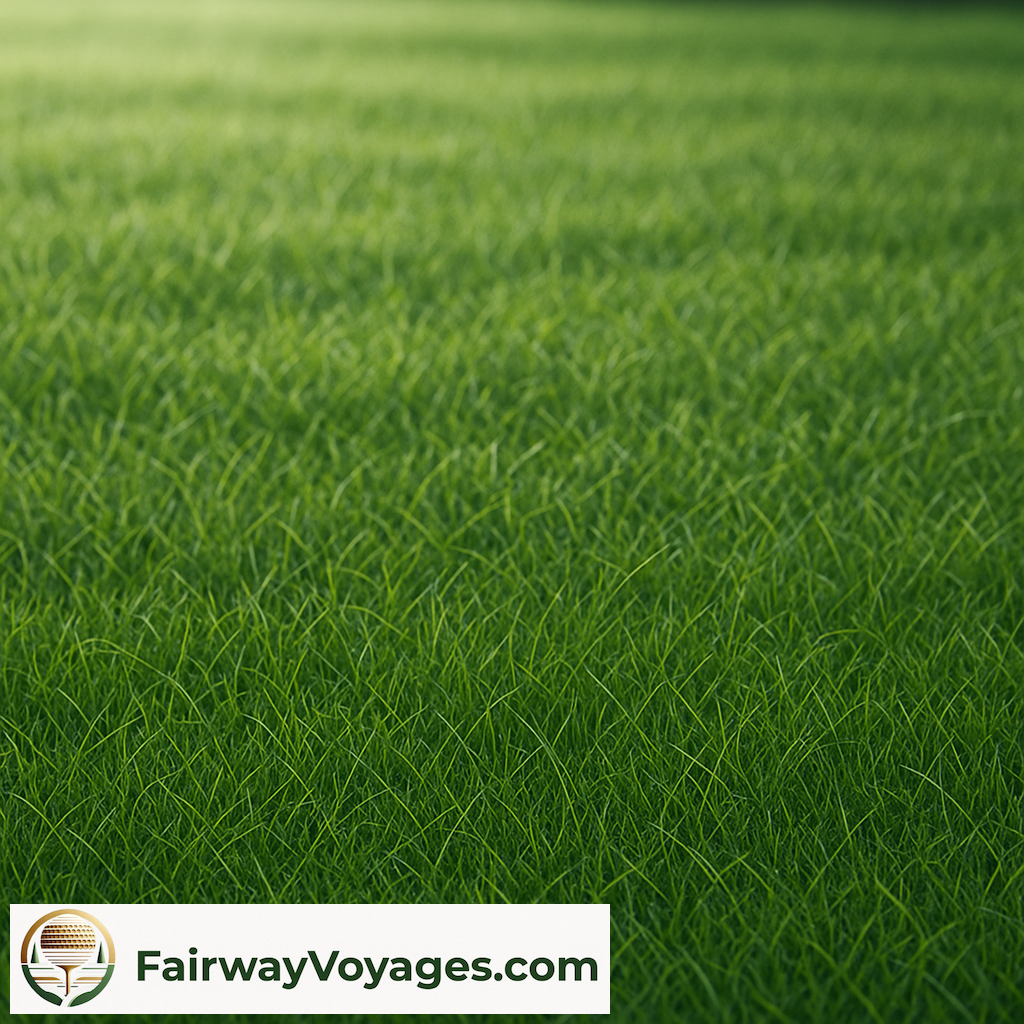 Bermudagrass (*Cynodon dactylon* and hybrids) is a warm-season
turfgrass widely used on golf courses throughout the southern
United States, the Caribbean, parts of South America, Africa, the
Middle East, and Asia. It thrives in hot climates with full sun
exposure and tolerates drought and high traffic exceptionally
well. Due to its aggressive growth and dense canopy, bermudagrass
is often used on fairways, tees, and even putting greens in warm
regions, especially since the development of ultradwarf cultivars
like TifEagle, MiniVerde, and Champion. These newer varieties
allow for extremely low mowing heights suitable for modern green
speeds.
Bermudagrass (*Cynodon dactylon* and hybrids) is a warm-season
turfgrass widely used on golf courses throughout the southern
United States, the Caribbean, parts of South America, Africa, the
Middle East, and Asia. It thrives in hot climates with full sun
exposure and tolerates drought and high traffic exceptionally
well. Due to its aggressive growth and dense canopy, bermudagrass
is often used on fairways, tees, and even putting greens in warm
regions, especially since the development of ultradwarf cultivars
like TifEagle, MiniVerde, and Champion. These newer varieties
allow for extremely low mowing heights suitable for modern green
speeds.
One of bermudagrass's standout benefits is its rapid recovery from damage, making it highly desirable for high-play areas like tees and fairways. It spreads via both stolons and rhizomes, allowing it to fill in divots and worn spots more quickly than many other grasses. Its durability and heat tolerance mean that it requires less water than cool-season grasses during summer months, though it still needs proper irrigation and fertilization to remain healthy and playable. It goes dormant and turns brown in colder months but remains viable and comes back in spring in frost-prone regions, making it a sustainable option for courses with long, hot summers.
The downside of bermudagrass lies in its sensitivity to shade and its dormancy in cooler temperatures. On shaded greens or beneath tree canopies, bermudagrass thins out quickly, leading to bare spots or uneven turf. This has led to many courses incorporating tree removal programs or switching to shade-tolerant turf in problem areas. Overseeding with ryegrass in fall is also a common strategy to maintain green color and playability during winter, particularly in transition zones such as the Carolinas or southern California. The practice requires careful timing and extra maintenance during the seasonal transitions.
Golfers often notice the distinct grain of bermudagrass greens, which affects ball roll depending on the direction of growth. Managing grain through frequent grooming, verticutting, and brushing is essential to ensure true putting surfaces. While the grain can be frustrating for inexperienced players, skilled golfers often use it to their advantage. Bermudagrass remains one of the most economical and sustainable options for warm-climate golf courses, thanks to its low water needs, fast recovery, and resistance to wear. Courses like TPC Sawgrass and many in Florida, Texas, and the southern U.S. rely heavily on bermudagrass to meet professional playing standards.
Couchgrass (Australian Bermuda)
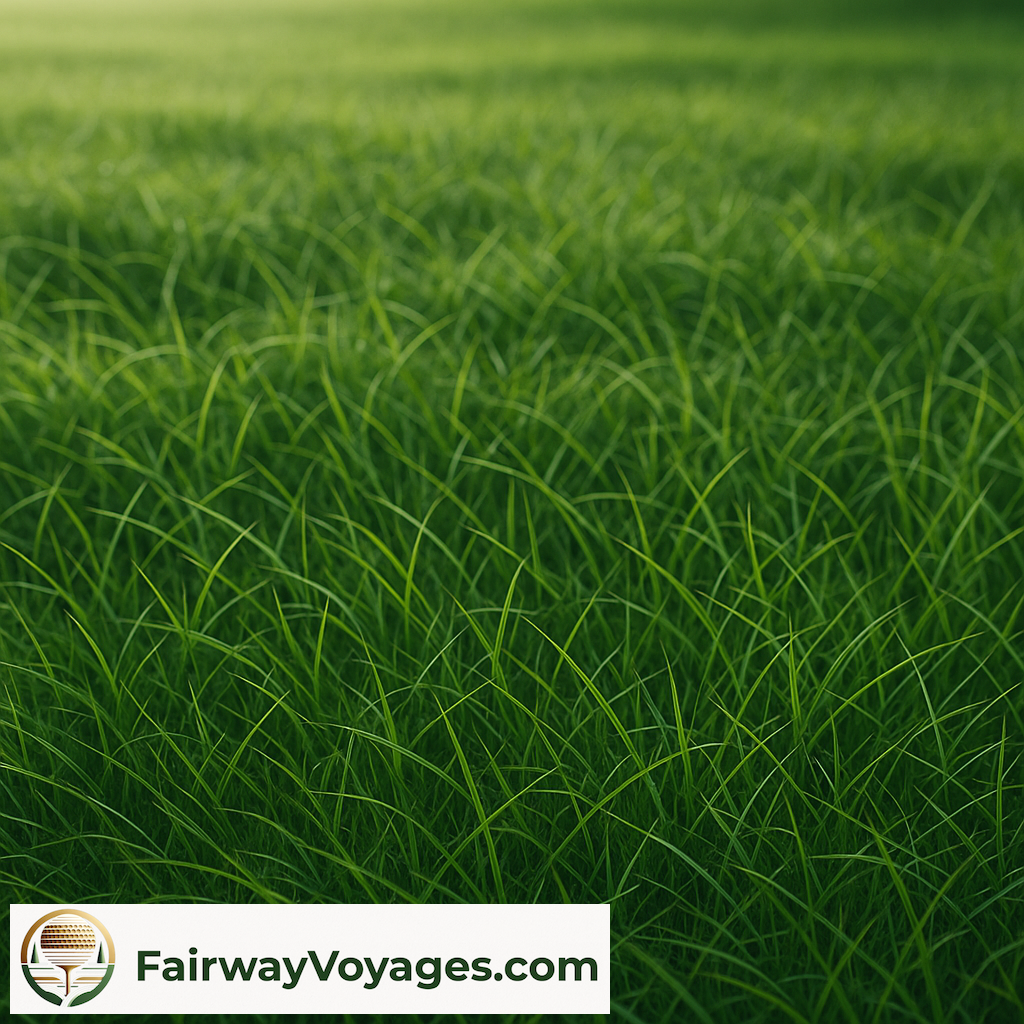 Couchgrass, commonly known as Australian bermuda, is a warm-season
turfgrass closely related to traditional bermudagrass but with
regional cultivars adapted specifically to the Australian climate.
Popular species include *Cynodon dactylon* and *Cynodon
transvaalensis*, often used in hybrid forms for improved turf
quality. This grass is a staple of Australian golf courses,
particularly in the warmer northern and coastal regions, and is
also widely used in parts of Asia and Africa with similar hot, dry
climates. It thrives in full sun, tolerates high levels of foot
and cart traffic, and provides a durable playing surface across
fairways, tees, and increasingly, greens.
Couchgrass, commonly known as Australian bermuda, is a warm-season
turfgrass closely related to traditional bermudagrass but with
regional cultivars adapted specifically to the Australian climate.
Popular species include *Cynodon dactylon* and *Cynodon
transvaalensis*, often used in hybrid forms for improved turf
quality. This grass is a staple of Australian golf courses,
particularly in the warmer northern and coastal regions, and is
also widely used in parts of Asia and Africa with similar hot, dry
climates. It thrives in full sun, tolerates high levels of foot
and cart traffic, and provides a durable playing surface across
fairways, tees, and increasingly, greens.
Couchgrass is prized for its dense, fine-bladed texture and vibrant green color during the growing season. It establishes quickly, spreads aggressively through stolons and rhizomes, and recovers rapidly from wear and damage. These traits make it ideal for golf courses that experience frequent play and need a resilient surface throughout the year. In Australian golf, couchgrass is often seen on high-profile courses like Royal Queensland and The Grange. Its ability to handle close mowing, particularly with hybrid varieties like Wintergreen, Santa Ana, and TifTuf, allows for excellent ball lies and consistent fairway conditions.
Despite its strengths, couchgrass does have limitations, particularly with shade tolerance and winter dormancy. In cooler southern climates or shaded areas of a course, it can become patchy or lose color during the colder months. To counteract this, many courses implement ryegrass overseeding programs in fall to maintain green coverage and playability through winter. Couchgrass also requires diligent maintenance to manage thatch buildup and prevent scalping during mowing. Proper verticutting, aeration, and fertilization are critical to ensuring it remains healthy and free of disease or weed invasion.
Players often appreciate the firmness and speed of couchgrass fairways, which promote longer ball roll and cleaner contact. On greens, ultradwarf hybrids are used to achieve smooth putting surfaces comparable to those made with traditional bentgrass or bermudagrass in warmer climates. Because couchgrass is well-suited to dry conditions and requires relatively less water than many cool-season grasses, it is a sustainable choice in water-conscious regions. With continued turf breeding in Australia and abroad, couchgrass remains a reliable and increasingly versatile option for golf courses operating in sun-drenched, high-play environments.
Fescue
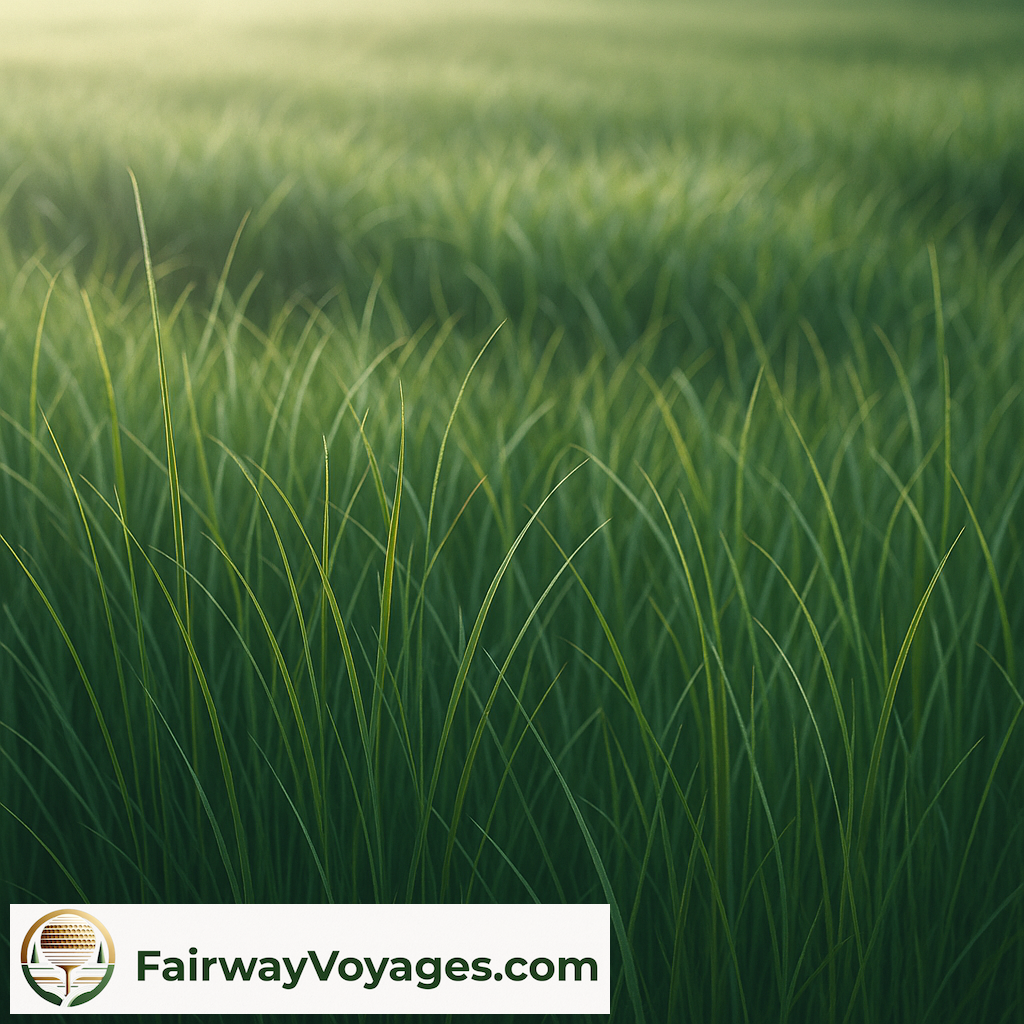 Fescue is a cool-season grass commonly used on golf courses
throughout Europe, the northern United States, Canada, and parts
of New Zealand. It encompasses a range of species, including red
fescue (*Festuca rubra*), chewings fescue (*Festuca rubra ssp.
commutata*), hard fescue (*Festuca trachyphylla*), and sheep
fescue (*Festuca ovina*). Fescue thrives in temperate climates and
is especially valued for its low-input requirements and natural
look, making it a preferred choice for links-style and
environmentally conscious golf courses. It is often used in
roughs, fairways, and out-of-play areas but can also serve on
greens and tees in some traditional layouts, particularly in the
British Isles.
Fescue is a cool-season grass commonly used on golf courses
throughout Europe, the northern United States, Canada, and parts
of New Zealand. It encompasses a range of species, including red
fescue (*Festuca rubra*), chewings fescue (*Festuca rubra ssp.
commutata*), hard fescue (*Festuca trachyphylla*), and sheep
fescue (*Festuca ovina*). Fescue thrives in temperate climates and
is especially valued for its low-input requirements and natural
look, making it a preferred choice for links-style and
environmentally conscious golf courses. It is often used in
roughs, fairways, and out-of-play areas but can also serve on
greens and tees in some traditional layouts, particularly in the
British Isles.
Fescue is drought-tolerant, requires minimal fertilization, and performs well in sandy soils with low fertility, making it ideal for sustainable course management. It is slow-growing compared to other turfgrasses, which translates into less frequent mowing and reduced maintenance costs. Fescue thrives in full sun but also handles partial shade better than many cool-season alternatives. Its fine texture and natural color give it a classic aesthetic associated with famous Scottish courses like St Andrews, Carnoustie, and Royal Dornoch, where fescue dominates much of the playing surface and defines the course's character.
Unlike dense, uniform turf species, fescue creates a more varied and natural playing experience. In roughs, it grows in tufts and wisps, offering strategic challenges for golfers and encouraging shot creativity. On fairways and tees, it produces a firm surface with moderate ball roll, and while it's not commonly used on greens anymore, it was once the dominant putting surface before the introduction of bentgrass. Fescue's resistance to many common turf diseases and its adaptability to various soil types make it one of the most resilient grass options for low-input golf environments.
From a golfer's perspective, fescue roughs can be punishing when unmaintained but visually stunning and ecologically valuable. They support pollinators and local wildlife, contributing to biodiversity on and around the course. Fescue's ability to remain viable with minimal irrigation is especially important as golf courses seek to reduce water usage. While not ideal for high-traffic greens due to its slower recovery rate, fescue remains a cornerstone of traditional golf course design, especially for those aiming to emulate the wind-swept, firm-and-fast conditions found in coastal or inland links courses across Northern Europe.
Kentucky Bluegrass
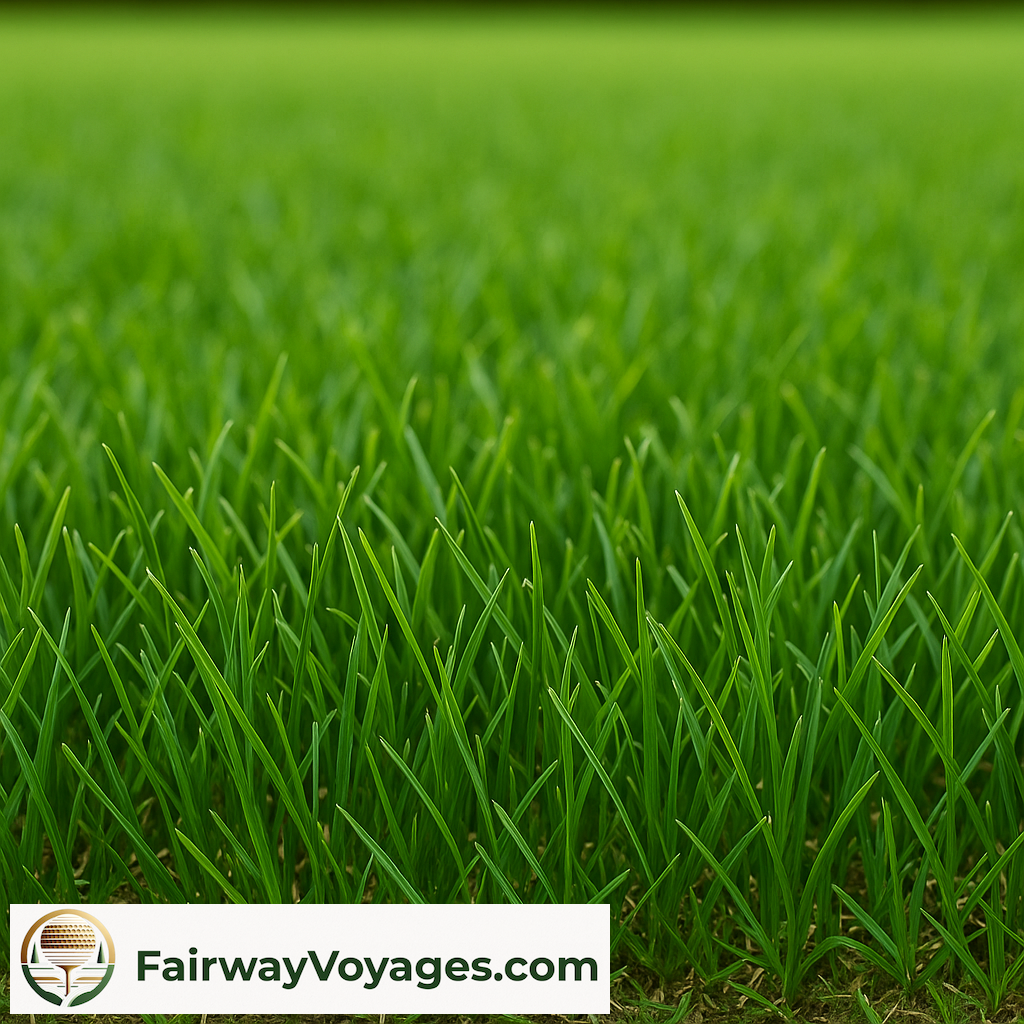 Kentucky bluegrass (*Poa pratensis*) is a cool-season turfgrass
widely used on golf courses in the northern United States,
southern Canada, and parts of Europe with temperate climates.
Known for its lush, deep green color and soft texture, Kentucky
bluegrass is especially popular for fairways, roughs, and tee
boxes. It thrives in full sun and well-drained soils, performing
best in regions with cold winters and mild to warm summers. Though
less commonly used on putting greens, it serves as an excellent
surface for general play areas due to its ability to withstand
traffic and recover from damage.
Kentucky bluegrass (*Poa pratensis*) is a cool-season turfgrass
widely used on golf courses in the northern United States,
southern Canada, and parts of Europe with temperate climates.
Known for its lush, deep green color and soft texture, Kentucky
bluegrass is especially popular for fairways, roughs, and tee
boxes. It thrives in full sun and well-drained soils, performing
best in regions with cold winters and mild to warm summers. Though
less commonly used on putting greens, it serves as an excellent
surface for general play areas due to its ability to withstand
traffic and recover from damage.
One of Kentucky bluegrass's most notable traits is its rhizomatous growth habit, which allows it to spread underground and form a dense, self-repairing turf. This characteristic makes it a valuable choice for high-wear areas, such as around tee complexes and landing zones on fairways. It is often blended with perennial ryegrass or fine fescues to enhance durability and provide quick germination in overseeded areas. Kentucky bluegrass is winter-hardy and maintains good color during cooler months, though it tends to struggle in prolonged heat or drought without supplemental irrigation.
While Kentucky bluegrass offers outstanding visual appeal and comfort underfoot, it does come with higher water and fertility needs compared to some other cool-season grasses. Its thatch layer can become problematic without regular aeration and topdressing. Disease pressures like leaf spot, summer patch, and rust are also concerns in humid climates, requiring vigilant management during peak growing seasons. Despite these challenges, Kentucky bluegrass remains a staple on premium golf courses aiming to provide a plush, uniform playing surface on fairways and roughs in cooler regions.
Golfers often enjoy the way Kentucky bluegrass interacts with the ball—providing a slightly cushioned lie that encourages solid contact, particularly with irons. Its thick sod base also resists divot displacement better than many other grasses, keeping fairways more intact throughout the season. Many iconic golf courses in the U.S. Midwest and Northeast, such as those in Ohio, Pennsylvania, and Illinois, feature Kentucky bluegrass in prominent areas. With ongoing advancements in breeding for drought tolerance and disease resistance, Kentucky bluegrass continues to evolve as a premier choice for cool-season golf course turf.
[more about kentucky bluegrass in golf courses]
[general information about kentucky bluegrass as a grass spieces]
Kikuyugrass
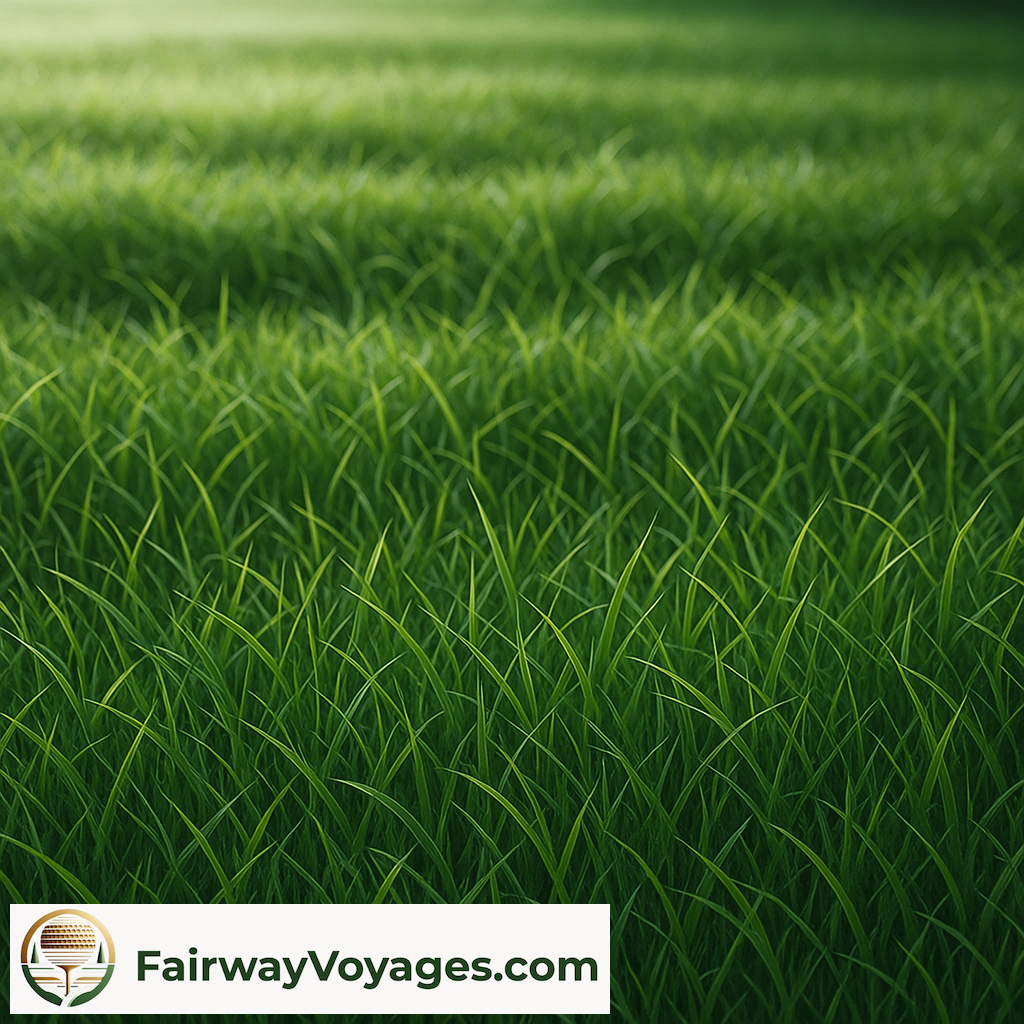 Kikuyugrass (*Pennisetum clandestinum*) is a warm-season turfgrass
originally from East Africa, now extensively used on golf courses
in temperate coastal climates such as Southern California, parts
of Australia, New Zealand, and South Africa. Known for its
aggressive growth and high drought tolerance, kikuyugrass thrives
in full sun and well-drained soils. It is particularly effective
on fairways, roughs, and tees, though it has also been adapted for
greens on certain courses due to its resilience. Courses like
Riviera Country Club and Torrey Pines in California feature
kikuyugrass prominently, using its dense mat for consistent lies
and reliable turf performance in dry, warm conditions.
Kikuyugrass (*Pennisetum clandestinum*) is a warm-season turfgrass
originally from East Africa, now extensively used on golf courses
in temperate coastal climates such as Southern California, parts
of Australia, New Zealand, and South Africa. Known for its
aggressive growth and high drought tolerance, kikuyugrass thrives
in full sun and well-drained soils. It is particularly effective
on fairways, roughs, and tees, though it has also been adapted for
greens on certain courses due to its resilience. Courses like
Riviera Country Club and Torrey Pines in California feature
kikuyugrass prominently, using its dense mat for consistent lies
and reliable turf performance in dry, warm conditions.
Kikuyugrass spreads rapidly through both stolons and rhizomes, forming a thick, carpet-like turf that resists erosion and recovers quickly from damage. This makes it ideal for high-traffic zones and slopes where maintaining turf density is critical. It remains green and lush throughout the summer with minimal irrigation, a significant advantage in regions facing water restrictions. However, it goes dormant and loses color during colder months unless overseeded with cool-season grasses. Despite its resilience, kikuyugrass is considered invasive in some regions due to its rapid spread and ability to outcompete other turf species.
While its thick canopy provides excellent wear tolerance and durability, kikuyugrass can be challenging to mow and maintain. Its fast growth requires frequent mowing, and its toughness can cause increased wear on mowing equipment. It also tends to form thatch quickly, requiring regular dethatching and aeration to maintain turf quality. Kikuyugrass is sensitive to certain herbicides, making weed management more complex. Nonetheless, advances in turf science have led to improved maintenance practices that enable superintendents to manage its growth while capitalizing on its drought resistance and playability.
From a golfer's perspective, kikuyugrass provides firm lies and minimal ball burying in the fairway, though it can be difficult to play from in the rough due to its thick, grabby texture. Its ability to maintain tight lies even in dry conditions allows for consistent shot-making with irons and wedges. On greens, it can be fast and true when maintained at low mowing heights, though less common than bentgrass or bermudagrass in this application. Kikuyugrass's combination of sustainability, wear resistance, and adaptability to coastal environments makes it a compelling choice for warm-climate golf courses aiming to balance performance with environmental responsibility.
Poa Annua
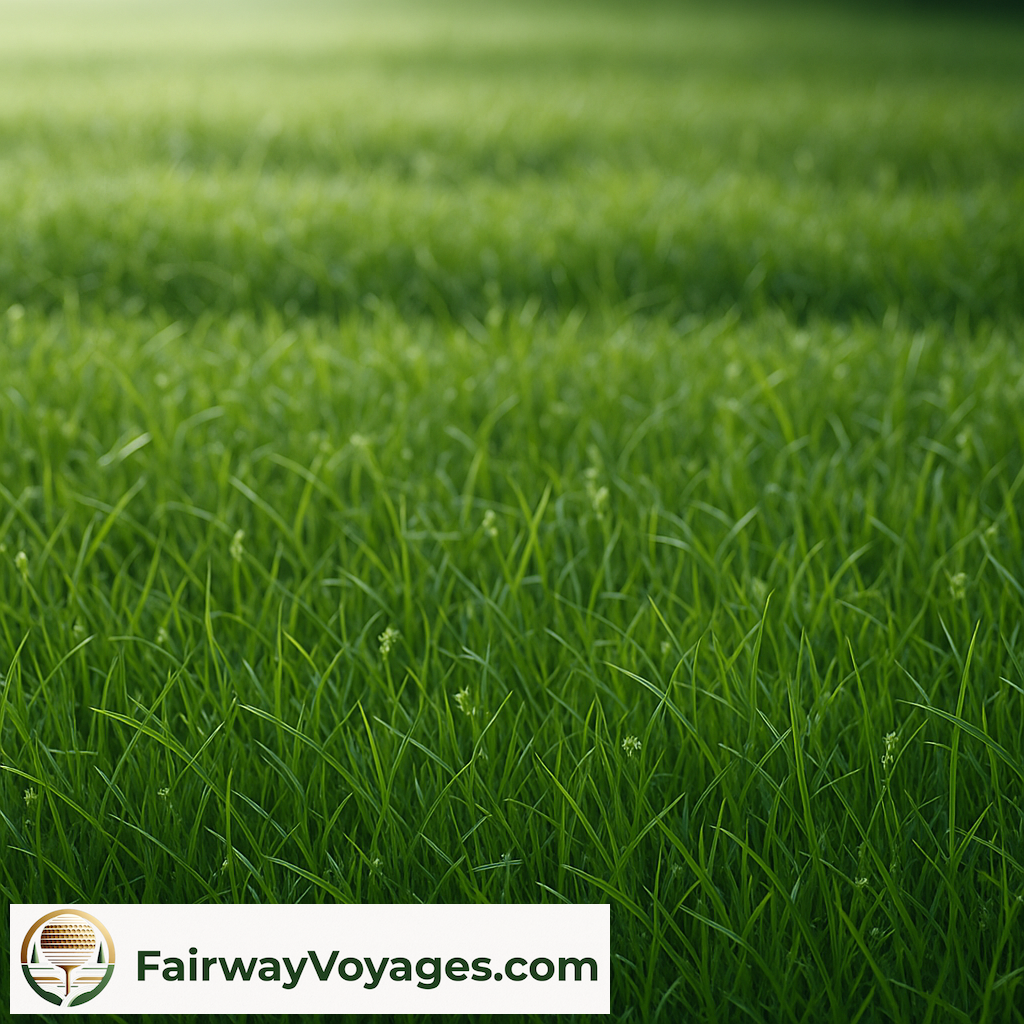 Poa annua, commonly known as annual bluegrass, is a cool-season
grass that naturally occurs on golf courses worldwide and, over
time, has become an intentional turf choice in many regions.
Originally considered a weed, it has adapted so well to close
mowing and high playability that it is now the dominant putting
surface at some of the most prestigious courses, particularly
along the U.S. West Coast and in parts of Europe. Courses like
Pebble Beach and Oakmont have long histories of managing Poa annua
greens with great success, showcasing its potential when properly
maintained.
Poa annua, commonly known as annual bluegrass, is a cool-season
grass that naturally occurs on golf courses worldwide and, over
time, has become an intentional turf choice in many regions.
Originally considered a weed, it has adapted so well to close
mowing and high playability that it is now the dominant putting
surface at some of the most prestigious courses, particularly
along the U.S. West Coast and in parts of Europe. Courses like
Pebble Beach and Oakmont have long histories of managing Poa annua
greens with great success, showcasing its potential when properly
maintained.
One of the key advantages of Poa annua is its ability to produce an incredibly smooth and fast putting surface when managed meticulously. It tolerates extremely low mowing heights, recovers quickly from wear, and is often favored for its performance during peak playing seasons. There are many biotypes of Poa annua—ranging from annual to perennial strains—resulting in varied behavior depending on the location and management style. In cooler coastal climates, such as the Pacific Northwest or Northern Europe, perennial Poa annua can provide year-round turf quality with the right maintenance regime.
However, Poa annua has a reputation for being high-maintenance. It has shallow roots and a high water demand compared to other cool-season grasses, making it susceptible to drought, disease, and inconsistent performance in extreme temperatures. It also tends to produce seed heads, even under low mowing, which can affect surface smoothness and aesthetics. Managing its seed head production requires careful use of growth regulators and specialized mowing techniques. Additionally, its tendency to become patchy or die off in heat makes it less reliable for regions with hot summers unless overseeded or integrated with more heat-tolerant species.
Despite its challenges, Poa annua remains highly regarded by many superintendents and professional players because of its ball response and putting consistency under tournament conditions. Its soft leaf blades allow for spin control, and seasoned golfers often become familiar with its unique grain and roll characteristics. Courses that have embraced Poa annua as their primary turf invest heavily in cultural practices, irrigation precision, and disease control to keep it at its best. As turf science advances, more resilient cultivars of Poa annua are being developed, offering new hope for courses in transitional climates looking to capitalize on its elite playability.
Ryegrass
 Ryegrass, primarily perennial ryegrass (*Lolium perenne*), is a
cool-season grass widely used on golf courses for overseeding,
tees, fairways, and roughs. It is known for its rapid germination,
vibrant green color, and ability to establish quickly, making it
ideal for transitional climates and high-traffic areas. Commonly
found throughout the northern United States, Europe, New Zealand,
and temperate parts of Australia, ryegrass is also extensively
used in the southern U.S. for winter overseeding of warm-season
grasses like bermudagrass to maintain visual appeal and
playability when those grasses go dormant.
Ryegrass, primarily perennial ryegrass (*Lolium perenne*), is a
cool-season grass widely used on golf courses for overseeding,
tees, fairways, and roughs. It is known for its rapid germination,
vibrant green color, and ability to establish quickly, making it
ideal for transitional climates and high-traffic areas. Commonly
found throughout the northern United States, Europe, New Zealand,
and temperate parts of Australia, ryegrass is also extensively
used in the southern U.S. for winter overseeding of warm-season
grasses like bermudagrass to maintain visual appeal and
playability when those grasses go dormant.
One of ryegrass's greatest strengths is its fast germination—typically within 5 to 7 days—allowing golf courses to recover quickly from wear or seasonal transitions. This makes it especially valuable for overseeding in fall, where it can provide immediate cover and vibrant color as bermudagrass fades. Its fine to medium texture offers a smooth, consistent playing surface for fairways and roughs, and modern cultivars are bred for improved disease resistance, drought tolerance, and mowing quality. Ryegrass also performs well in full sun and tolerates moderate shade better than many warm-season options.
However, ryegrass has a relatively shallow root system compared to other turfgrasses, which limits its drought resistance and makes it more dependent on irrigation in dry periods. It is also vulnerable to certain diseases such as gray leaf spot and crown rust, especially in humid or poorly drained conditions. Because it does not spread through stolons or rhizomes, it lacks the self-repairing capabilities of grasses like bermuda or Kentucky bluegrass. This means it often needs to be re-seeded in worn areas or where damage occurs. Despite these drawbacks, its reliability in germination and versatility in transitional climates keep it in high demand.
Golfers generally appreciate ryegrass for its dense, upright growth and clean strike surface, particularly on tees and fairways. It delivers a firm feel underfoot and a neat visual presentation that enhances the look of a course. Its overseeding use in southern courses helps ensure continuity in aesthetics and playability throughout the year. While ryegrass is not typically used on putting greens due to its coarser leaf texture and mowing limitations, it plays a crucial supporting role across a course. Its adaptability, ease of establishment, and crisp playing quality make it a go-to option for superintendents seeking a quick, dependable turf solution.
Seashore Paspalum
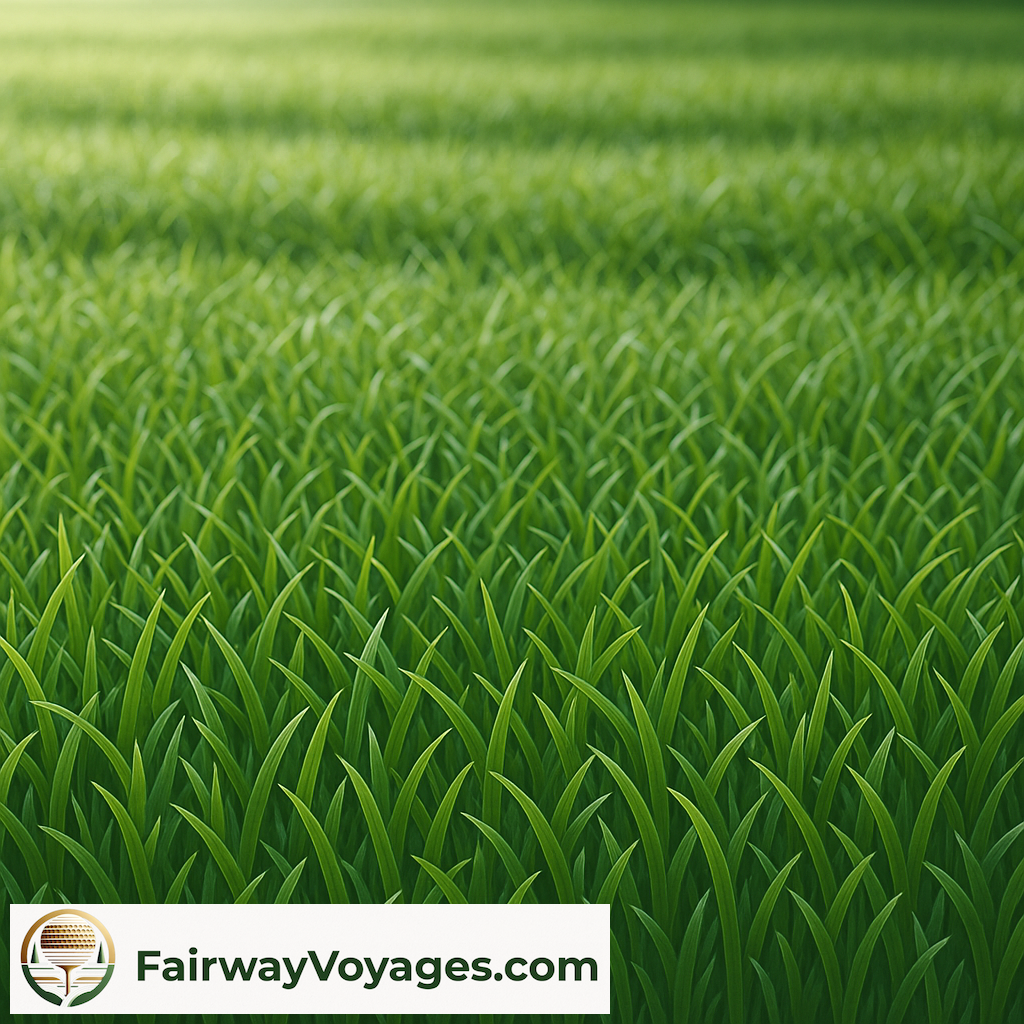 Seashore paspalum (*Paspalum vaginatum*) is a warm-season
turfgrass renowned for its exceptional salt tolerance, making it
an ideal choice for golf courses in coastal regions with brackish
water or salt spray exposure. It is widely used in tropical and
subtropical climates across the southern United States, the
Caribbean, the Middle East, Southeast Asia, and Pacific Islands.
Seashore paspalum performs best in sandy soils with good drainage
and can even be irrigated with effluent or saline water, making it
a highly sustainable option in areas facing freshwater
scarcity.
Seashore paspalum (*Paspalum vaginatum*) is a warm-season
turfgrass renowned for its exceptional salt tolerance, making it
an ideal choice for golf courses in coastal regions with brackish
water or salt spray exposure. It is widely used in tropical and
subtropical climates across the southern United States, the
Caribbean, the Middle East, Southeast Asia, and Pacific Islands.
Seashore paspalum performs best in sandy soils with good drainage
and can even be irrigated with effluent or saline water, making it
a highly sustainable option in areas facing freshwater
scarcity.
This grass is used extensively on tees, fairways, roughs, and increasingly on putting greens, thanks to newer cultivars that tolerate low mowing heights and deliver a smooth surface. Popular varieties like Platinum TE, SeaIsle 2000, and SeaDwarf are designed for high-performance golf applications. Seashore paspalum offers a fine texture, a rich green color, and a dense growth habit that creates a visually striking and highly playable surface. It thrives in warm, humid environments and exhibits excellent wear tolerance, though its growth slows considerably in cooler temperatures, which limits its use in more temperate zones.
One of the key benefits of seashore paspalum is its ability to recover quickly from damage due to its aggressive lateral growth. It spreads through stolons and rhizomes, allowing for rapid fill-in of divots and worn areas. It also responds well to vertical mowing and light topdressing, helping superintendents maintain consistent surface quality. However, paspalum requires careful nutrient management—particularly low nitrogen and salt-tolerant fertilizers—to avoid excessive thatch and discoloration. It is sensitive to certain herbicides, which can complicate weed control compared to more chemically resilient turf species.
From a golfer's standpoint, seashore paspalum provides a cushiony, uniform lie with a soft yet stable surface ideal for striking the ball cleanly. Greens constructed with paspalum can offer speeds and trueness comparable to those of bermudagrass or bentgrass, provided they are mowed and maintained properly. Its smooth appearance and ability to retain color under high salinity make it a favorite for resort and championship courses in coastal destinations like Hawaii, the Dominican Republic, and Dubai. With its sustainability profile and performance under extreme environmental conditions, seashore paspalum continues to gain popularity among turf managers and course designers alike.
Zoysiagrass
 Zoysiagrass is a warm-season turfgrass highly valued for its
durability, density, and low maintenance requirements, making it
an increasingly popular choice for golf courses in temperate and
subtropical regions. Native to Asia, it has been widely adopted in
the southern and transition zones of the United States, as well as
in parts of Australia, South Korea, and Japan. Zoysia grows well
in a wide range of soils and climates, tolerating heat, drought,
and moderate shade. It is often used on fairways, tees, and
roughs, and with newer cultivars like Zeon and L1F, it is even
being used on greens in some specialized applications.
Zoysiagrass is a warm-season turfgrass highly valued for its
durability, density, and low maintenance requirements, making it
an increasingly popular choice for golf courses in temperate and
subtropical regions. Native to Asia, it has been widely adopted in
the southern and transition zones of the United States, as well as
in parts of Australia, South Korea, and Japan. Zoysia grows well
in a wide range of soils and climates, tolerating heat, drought,
and moderate shade. It is often used on fairways, tees, and
roughs, and with newer cultivars like Zeon and L1F, it is even
being used on greens in some specialized applications.
One of zoysiagrass's most notable traits is its dense, mat-like growth, which provides a consistently smooth surface and superior wear tolerance. It spreads by both stolons and rhizomes, forming a tight sod that resists weed encroachment and erosion. Its thick canopy helps minimize divots and provides a firm, forgiving base for clean ball strikes. Although slower to establish than some other grasses, once mature, it requires less mowing, fertilization, and water than many alternatives. This makes it an attractive option for environmentally conscious courses seeking to reduce inputs without sacrificing turf quality.
Zoysiagrass does have some limitations. It enters dormancy and turns brown in cooler temperatures, typically around 50°F (10°C), which limits its visual appeal and playability in colder seasons unless overseeded. Its dense texture, while beneficial for play and weed control, can make mowing more labor-intensive, particularly when it becomes thatchy. Additionally, it tends to be slow to recover from damage compared to more aggressive species like bermudagrass, requiring thoughtful traffic management and cultural practices to maintain uniformity in high-wear areas.
From a player's perspective, zoysiagrass offers a firm and predictable lie, especially on fairways. Balls tend to sit up slightly on the dense turf, which many golfers appreciate for ease of clean contact. Its tolerance for foot and cart traffic, combined with its soft feel underfoot, contributes to a high-quality playing experience. Courses such as Bellerive Country Club and Trinity Forest Golf Club have used zoysiagrass extensively to achieve elite conditions with sustainable practices. As new cultivars are developed with improved cold tolerance and faster growth rates, zoysiagrass is poised to play an even greater role in modern golf course design and maintenance.
